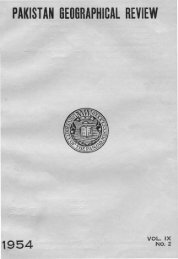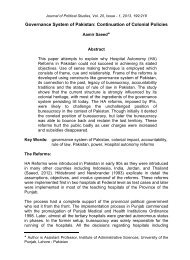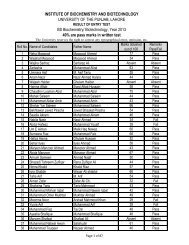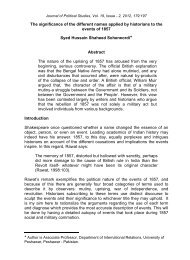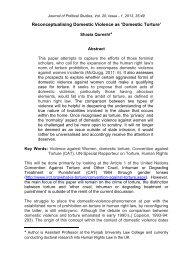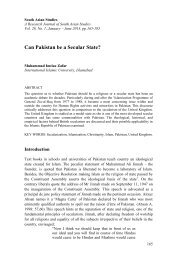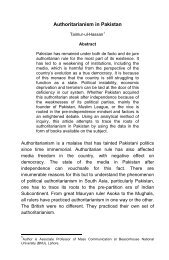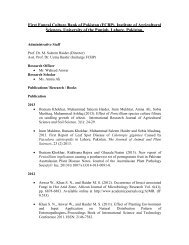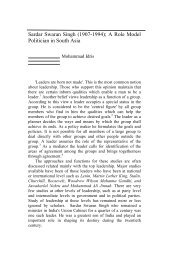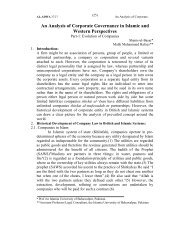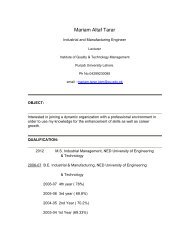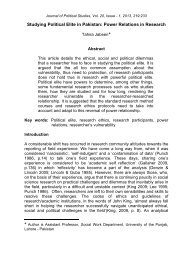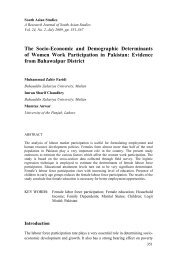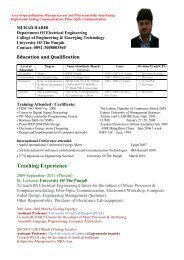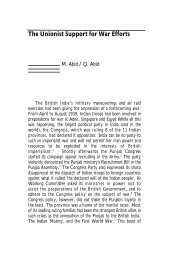4. Dr. Amir M. Haji Yousefi_January-June 2012
4. Dr. Amir M. Haji Yousefi_January-June 2012
4. Dr. Amir M. Haji Yousefi_January-June 2012
You also want an ePaper? Increase the reach of your titles
YUMPU automatically turns print PDFs into web optimized ePapers that Google loves.
South Asian Studies 27 (1)<br />
proves that this historic pattern has not changed and can not be changed through<br />
military force. At the present time it seems that the U.S. is committing a strategic<br />
mistake by not only keeping its forces in Afghanistan but also increasing their<br />
number with the aim of removing Taliban and defeating global terrorism<br />
(Daheshyar, 2008). After approximately a decade of war in Afghanistan, the<br />
Taliban forces are not dismantled, rather they are making their adversary accept<br />
their role in the future of Afghanistan. Their presence in the south and south<br />
eastern Afghanistan and their incursions against the NATO forces have led the<br />
Western countries including the U.S. to think of a new strategy of dealing with<br />
Taliban (Tellis, 2009).<br />
According to Tehran, the U.S. once again is in sticky situation in Afghanistan<br />
and this is the only reason the American authorities are thinking again of<br />
contacting Iran and asking her assistance (Ghafoori, 2009). Since Iran’s previous<br />
contributions to the peace and security in Afghanistan have not been<br />
acknowledged by the U.S. and NATO, the Iranian positive reaction seems far-off.<br />
However, it may open a new ground for the Iran-U.S. contacts in Afghanistan. It is<br />
in Iran’s interest that the U.S. and NATO forces come to the realization that there<br />
is no solution to Afghanistan chaos without the active participation of the<br />
neighbouring countries. This is what Iran insists on as a regional solution to this<br />
issue. As one author close to decision-making circles in the Islamic Republic<br />
argues, Iran would not cooperate with the U.S. and NATO forces if they do not<br />
accept Iran’s policy of regional solution (Mottaghi, 2010). Iran now believes that<br />
its direct and indirect cooperation with the U.S. in Afghanistan crisis especially<br />
during the American invasion to remove Taliban and immediately after that in Bon<br />
Conference did not decrease the tension in their relationship since the U.S. was<br />
looking for a separate agenda. Accordingly the natural alliance of Iran-U.S. in<br />
Afghanistan did not alter American policy of regime change in Tehran (Dehghani,<br />
2009: 490). Thus, the future of Iran-U.S. relation in Afghanistan is at best<br />
competitive and at worst confrontational.<br />
The Islamic Republic of Iran sees the military presence of the U.S. in<br />
Afghanistan and other neighbouring countries (Iraq, the Persian Gulf and Central<br />
Asia) as its encirclement in order to contain the Islamic revolution ideals, on one<br />
hand, and change the regime in Tehran on the other. Therefore, it can be said that<br />
one of the strategic goals of the U.S. in attacking Afghanistan and continuing its<br />
occupation was to prevent Iran’s influence in Afghanistan. Another main goal<br />
might be to cut the connections of Iran and Central Asia which regarded by Iran as<br />
its zone of cultural and civilization influence. Looking at the occupation of<br />
Afghanistan from this angle, it could be imagined why Tehran is harshly opposing<br />
the American and NATO presence there. Iran’s security and interest are highly<br />
threatened. Accordingly, Tehran considers the fact that the U.S. presence in<br />
Afghanistan can be effective in the provocation and creation of insecurity in the<br />
East of Iran (Khani, 2005: 88). Further, it will facilitate the presence of countries<br />
such as Saudi Arabia, a U.S. regional ally, who according to Tehran seeks to<br />
72



